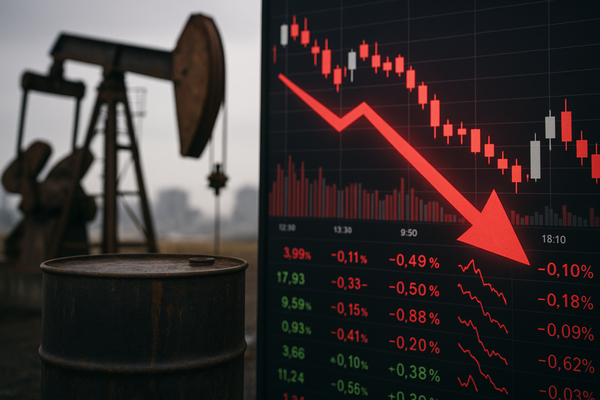
U.S. sanctions on Russia’s two largest oil firms are driving a sudden rise in crude and adding fresh trade and inflation anxiety to markets. Oil jumped about 4 percent and U.S. crude climbed above $60 a barrel as investors and shippers reassess flows. Short term this means tighter energy supply perceptions and higher Treasury yields. Long term it raises questions about trade routes, buyer behavior in Asia and the resilience of global energy markets. The move matters now because it coincides with weak technology earnings, a pending U.S. inflation print and renewed U.S.-China export frictions that together could amplify market volatility across the United States, Europe and Asia.
Sanctions push oil higher and test market nerves
The White House hit Rosneft and Lukoil with new measures that followed British action and an EU package that includes a ban on Russian LNG. Markets reacted quickly. Oil spiked roughly 4 percent and Brent and U.S. crude moved to two week highs. India told refiners they might sharply curtail imports to comply with U.S. rules, underscoring how sanctions can redirect flows across Asia.
Energy prices are a live input to inflation and to policy calculations. Treasury yields rose despite a solid 20 year bond auction, the dollar firmed and the yen weakened to levels not seen since early October. Gold recovered some ground after earlier losses. In the short run traders will watch whether import curbs by key buyers such as India tighten physical markets further. Over time the measures could accelerate efforts by buyers and producers to reroute trade, build alternative supply lines or accelerate domestic energy strategies in Europe and Asia.
Tech earnings add pressure ahead of U.S. inflation data
Corporate results added to the drama. Tesla (NASDAQ:TSLA) tumbled after a fourth straight profit miss. Netflix (NASDAQ:NFLX) posted a sharp earnings-day drop near 10 percent and Texas Instruments (NASDAQ:TXN) slid around 6 percent. The cumulative effect pushed the S&P 500 down about 0.5 percent as U.S.-China trade rhetoric intensified.
Intel (NASDAQ:INTC) leads a packed earnings calendar on Thursday and investors will parse guidance closely. The Philadelphia Semiconductor index fell roughly 2.4 percent as the market weighed the dual hit of disappointing chip demand and the threat of new export controls. Washington is reportedly considering curbs on a broad array of software-powered exports to China in response to Beijing’s rare earth restrictions. That prospect has heightened market fear that trade measures could extend beyond hardware into complex supply chains.
Europe faces a delicate trade and security balancing act
European policymakers are confronting a complex mix of security and commercial pressures. The European Union in recent moves has chosen not to retaliate against U.S. tariff measures, in part to keep strategic alignment with Washington over Russia. At the same time European manufacturers face the risk of higher imports from China if Beijing redirects excess capacity toward the bloc. Germany’s trade patterns through the first eight months of 2025 illustrate the point. China regained its place as Germany’s largest trading partner while German exports to the United States fell more than 7 percent year on year and exports to China fell about 13.5 percent. Imports from China rose over 8 percent.
Policy actions have already spilled into industrial operations. Dutch authorities seized control of chipmaker Nexperia after security concerns about the Chinese owner. Beijing responded by blocking exports of some finished products, which alarmed European automakers and raised warnings of potential production hits. More broadly, China’s curbs on rare earths have emerged as a bargaining chip that could disrupt industries beyond the United States and complicate Europe’s decarbonisation and manufacturing plans.
Market calendar and near term scenarios
Investors enter the session with several macro and corporate events on the slate. The September U.S. inflation report is due shortly and could recalibrate expectations for rate policy if surprises emerge. U.S. existing home sales, the Kansas City Fed business survey and euro zone consumer confidence data will all attract attention. Key central bank figures will speak, including a Federal Reserve supervisory vice chair and an ECB economist, which could add nuance to policy debate.
Corporate results will continue to influence sectoral performance. Names scheduled around the reporting window include Blackstone (NYSE:BX), Ford (NYSE:F), Dow (NYSE:DOW), PG&E (NYSE:PCG), Honeywell (NASDAQ:HON), Newmont (NYSE:NEM), Norfolk Southern (NYSE:NSC), Union Pacific (NYSE:UNP), VeriSign (NASDAQ:VRSN), Mohawk (NYSE:MHK), Valero (NYSE:VLO), Dover (NYSE:DOV), Allegion (NYSE:ALLE), Hasbro (NASDAQ:HAS), Southwest Airlines (NYSE:LUV), Textron (NYSE:TXT), Pool (NASDAQ:POOL), CBRE (NYSE:CBRE) and Roper (NYSE:ROP). Markets will watch earnings beats and misses for signs of demand resilience or softening across sectors.
How to read this confluence
The current mix of geopolitics, sanctions and corporate disappointment creates a layered risk environment. In the short run traders can expect bouts of repricing as information arrives on sanctions enforcement, import adjustments by major buyers and earnings guidance from major issuers. Over a longer horizon the episodes may accelerate diversification of supply chains, increase political scrutiny of foreign investment in critical sectors and push policymakers to tighten controls on strategic exports.
For global investors the immediate considerations are clear. Energy markets now carry a political risk premium. Technology and semiconductor names remain sensitive to export policy and to demand signals from China and other large markets. European industry faces the dual test of managing security exposure while retaining competitiveness. These dynamics will play out against macro reads such as the U.S. inflation print and upcoming central bank commentary that together will help set the tone for risk assets in the coming weeks.
Data and events will change market postures rapidly. Traders and asset managers will be watching both headlines and economic prints closely to decide whether recent moves are transitory or part of a broader repricing that could influence policy and portfolios for months to come.


